|
ENTS,
Over the past two days, Dale Luthringer has been conducting a
Teacher's Workshop at Cook Forest State Park and other areas
focusing on old growth forest ecology. The blurb for the
program was:
OLD GROWTH FOREST ECOSYSTEMS TEACHER WORKSHOP
Cook Forest State Park and the North Central Region
Math/Science Education Collaborative will be conducting an 'Old
Growth Forest Ecosystems Teacher Workshop' on 8/6-7/09. This
two-day workshop will emphasize identification of old growth forest
characteristics when delineating forest types between ancient and
younger age stands within Cook Forest State Park, Hearts Content,
and Anders Run Natural Areas. Various forest mensuration
tools and techniques will be utilized. Advanced tree identification
via ancient bark character and shape will be presented as well as
field identification of reptiles, birds, and amphibians associated
with old growth forests. Teachers will receive a copy of 'Eastern
Old Growth Forests: Prospects for Rediscovery and Recovery' by Mary
Byrd Davis and will have the option to receive ACT 48 hours.
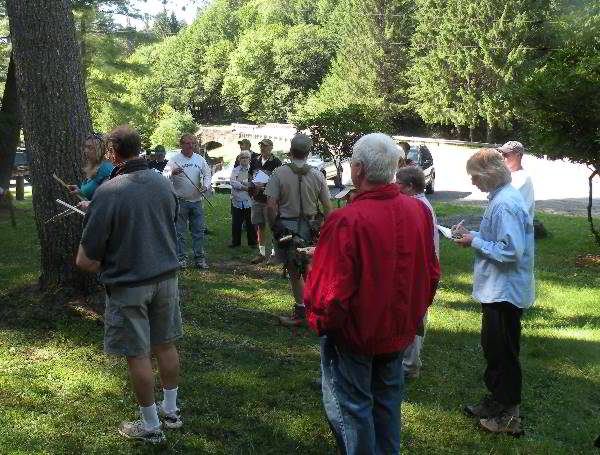 learning to use a Biltmore stick learning to use a Biltmore stick
When I first saw the announcement, I immediately volunteered to
help hime with the workshop, not that I actually thought I could be
much help. I figured I could pass things out, help the teachers
with their tree identification, and perhaps slap a few around who
got out of hand. Really I just want to take the course
for my own information.
I arrived early Thursday morning because the computer I donated
to their nature center was malfunctioning again and I wanted to try
and fix it before the workshop. That didn't work, but by 8:00 or so
people were starting to arrive. Altogether a couple dozen people or
so were taking the workshop. Dale had morning snacks for everyone
and soon after doing some paperwork everyone settled down for the
course. Dale first outlined the schedule for the next two days and
then launched into a power point presentation on old growth forests.
I must say the presentation was very informative. He discussed
various characteristics that could be used to tell if a tree was
old. These ranged from size, to upturned branches and reiterations,
to stag-head crowns, to curved limbs, various types of bark
characteristics. From here he went on to discuss the general
characteristics of old growth forests that cold be seen in the
field, Most of the photos were from Cook Forest, but he also used
examples from other sites he has visited in Pennsylvania - Anders
Run, Gettysburg, Erie, various cemeteries. He also had shots from
the Niagara Gorge near Niagara Falls, NY and ONT. Overall it was a
fantastic presentation. I have been encouraging (read as brow
beating) him to write an article outlining the characteristics he is
using to determine what trees are old and estimate their ages in the
field for publication on the ENTS list, the website, and perhaps the
Bulletin. The photos he had were great and I learned quite a bit
because it was presented in an organized way rather than the hit and
miss way myself, and perhaps any of you are picking up this type of
information. You really start noticing certain characteristics in
the field when they are on your mid. Sure you may have noticed them
before, and they may have been in the back of your mind, but once
you focus on something I have found you begin to see more and more
of them as you are exploring. That is true of old-growth limb
characteristics, small species such as hawthorns, or any of a myriad
of other features, Once they are in you thoughts, you see more of
them.
After the presentation Dale demonstrated how to use a Biltmore
stick. I am sure it was fun to try and learn how to use one. If
you are proficient in using one in the forest, perhaps you can
quickly collect many diameter measurements. However in the case of
the teachers the process of measuring diameter with a stick was
slow, and many of the readings were hideously bad. They would have
been better off in terms of speed and accuracy to simply use a
D-tape. But the point was to expose them to different measuring
techniques and a Biltmore stick is one of them.
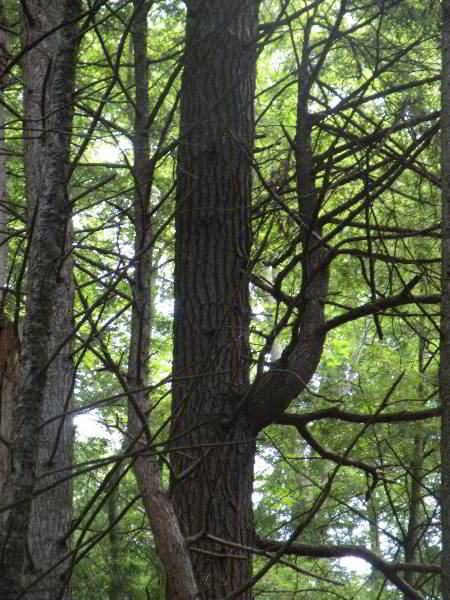 "Preacher arms" on a white pine. "Preacher arms" on a white pine.
From here Dale went over tree identification using some trees
right beside the Log Cabin Inn. He pointed out white pine, eastern
hemlock, beech, yellow birch, black cherry, and black birch. The
focus was on looking at the bark as a distinguishing factor in the
identification. He also had everyone smell the scent from the
cambium of of the birches ad black cherry. From here we
went up the Longfellow trail to the edge of the old growth. here he
pointed out the different characteristics found on the bark of old
white pine and hemlock trees, limb patterns he had shown in photos
earlier, coarse woody debris, standing dead snags, trees in a row
from nurse logs, a white oak bent and twisted by age a and a big
lightening scar. he discusses the role of deer population in the
lack of regeneration in the understory of the old growth forest.
How we have lost several age families of seedling and saplings over
the past seventy years because of over browsing.
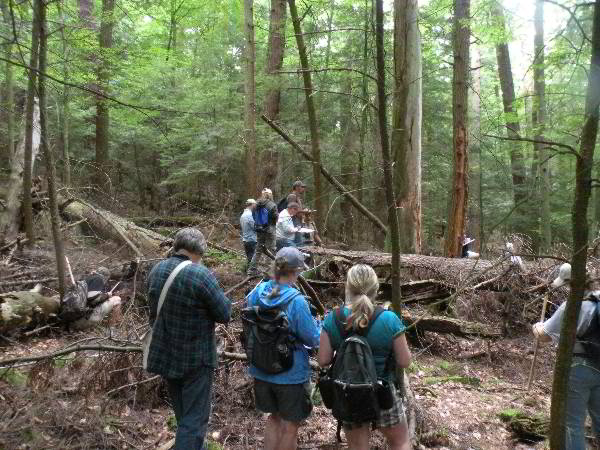 Working on the transect Working on the transect
After this we headed up to the Seneca Pine. he talked about
other things on the way such as nurse logs, recycling of CWD, fungus
and moss. Once at the Seneca Pine the people taking the course were
given their first fieldwork assignment. They were to run a transect
of 50 meters in length, 10 meters wide through the old growth
forest, noting and measuring the girth any living trees greater than
24" in diameter within the transect., any standing dead trees with a
diameter greater than 20" in the transect, ad any downed trees that
crossed the center line of the transect that were greater than 20"
in diameter. For the fallen trees the entire length of the fallen
log was noted as well as the upper and lower diameters of the log.
In addition they were to note other tree species present that were
there, but too small for inclusion the calculation, any birds seen
or heard, and to look for whatever amphibians present in the area in
springs or under logs and rocks. This is a somewhat simplified
version of a more thorough transect, but appropriate for the time
constraints and for demonstration purposes. They stretched out
tapes, used the Biltmore sticks, and D-tapes, looked under logs and
jotted down all the information. Those who are taking the workshop
for additional credit will complete a "homework" assignment from
data collected on this transect, and similar transects conducted at
each of the four different sites we visited. The transect ran from
near the base of the Cornstalk pine out to almost the intersection
of the Indian trail ad the Longfellow trail, by the National Natural
Landmark sign for those of you who are familiar with the site. By
this time we were running late and we did not make the trip further
out the Longfellow Trail to the Longfellow Pine, nor out to the
downed 436 year-old Cucumbertree. On the way back Dale stopped and
demonstrated how the increment borer worked taking a core from a
large hemlock tree and successfully not getting the bit stuck. I
have some videos of portions of these discussions that I will post
over the next few days.
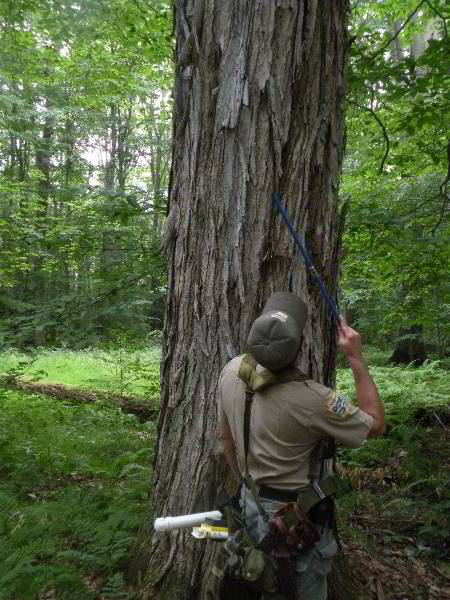 Shaggy red maple in maple Drive area Shaggy red maple in maple Drive area
We returned to the Log Cabin Inn and after a short break headed
over to the Maple Drive area of the park to look at a different type
of old-growth forest. Dale pointed out some old growth
characteristics at the site. Then he cored a section of an old
white oak tree demonstrating the tree was at least 150 years old as
he suggested based upon estimates based upon bark and limb
characteristics. Everyone did another transect and collected data.
After this a short walk through a portion of the area took us to
some other old trees. There were fallen trees with an upturned root
clump - pit and mound topography. There was one of the shaggiest
red maples I have ever seen, ad a number of tree species was had not
encountered in the Forest Cathedral area of the park. End of Day 1.
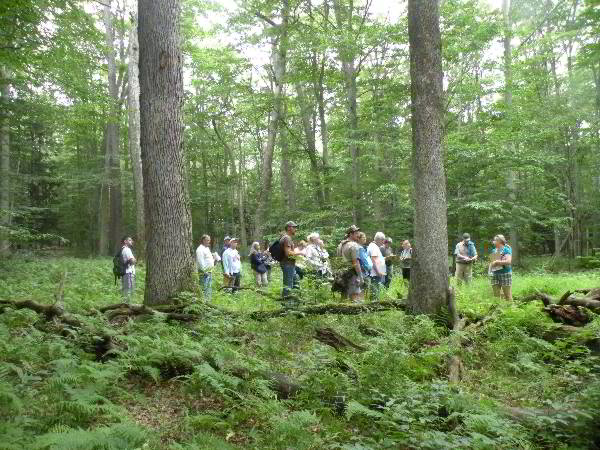 Maple Drive area Maple Drive area
Day 2 started with everyone meeting at the Log Cabin Inn there at
Cook Forest and car pooling to Anders Run Natural Area farther north
near Warren, PA. I had never actually visited there before. I had
driven past it many times as it is along the road to the uppermost
of the islands in the Allegheny River Islands Wilderness. We parked
along the road across from the snag of the Cornplanter Pine, once
the largest volume pine in PA, now dead. There were a number of old
trees and different species here for the teachers to see.
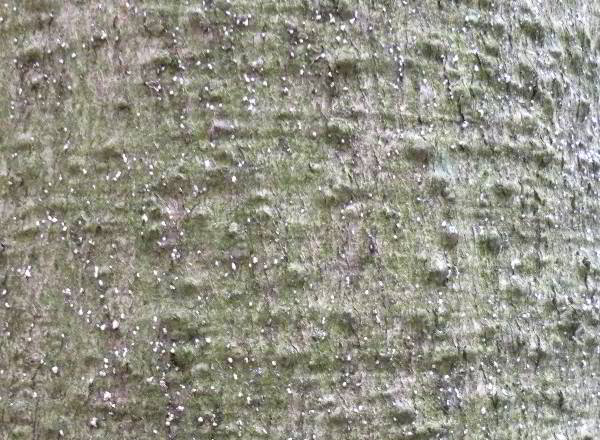 Beech Bark disease Beech Bark disease
The beech in this area are being hit hard by Beech Bark Disease.
The disease results when bark, attacked and altered by the beech
scale, Cryptococcus fagisuga Lind., is invaded and killed by fungi,
primarily Nectria coccinea var. faginata Lohman, Watson, and Ayers,
and sometimes N. galligena Bres. http://www.na.fs.fed.us/spfo/pubs/fidls/beechbark/fidl-beech.htm
The little white bumps that are the first stage of the disease were
visible on most of the beech trees that were not already dead.
There were some really nice examples of coral fungus. One person
found an intact porcupine skull complete with teeth, and we even
found an uncommon orchid growing along the trail. I need to look up
the species, We ran another transect at this site along the stream
flat that runs between the stream and the road.
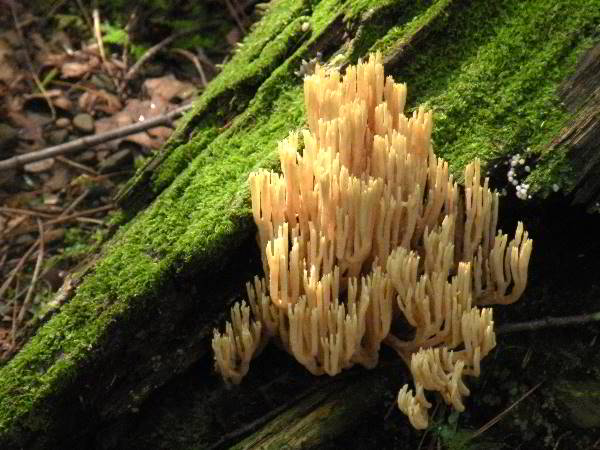 Coral
Fungus Coral
Fungus
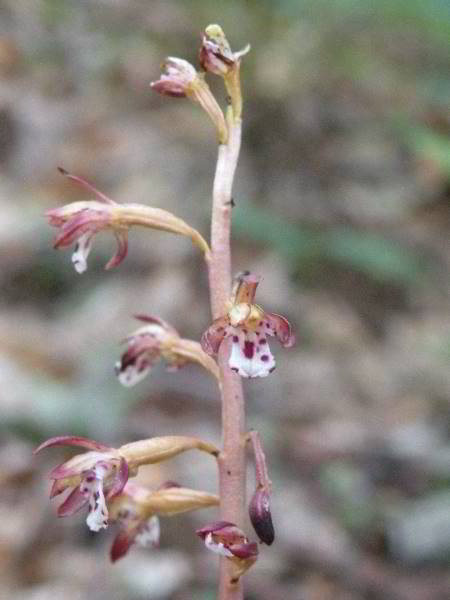 Spotted Coral Root
Spotted Coral Root
From here we left for the Hearts Content Scenic Area in the
Allegheny National Forest. This is perhaps the second best site in
Pennsylvania to see large white pines and hemlocks. http://www.fs.fed.us/r9/forests/allegheny/recreation/camping/heartsco...
"In the mid 1800's, a 20 acre parcel was protected from logging by the
Wheeler and Dusenbury Lumber Company. This parcel of original
forest, often called "old growth" or "virgin" timber was donated to
the Forest Service in 1922. In the following decades, more land was
purchased to make up the Allegheny National Forest as we know it
today. In 1934, the virgin timber area and 102 acres of the land
surrounding it was designated a "Scenic Area" by the Chief of the
Forest Service. The Civilian Conservation Corps built the pavilions
and the campground south of the road in 1936. The Scenic Area was
dedicated as a National Natural Landmark in 1977. The original
forest was a mixture of white pine, Eastern hemlock, and American
beech, with a multi-layered understory of hobble bush, witch hazel,
and many other species. Time, weather, insects, and disease have all
affected the forest in different ways, along with a high population
of deer. These have changed, and will continue to change, the
species composition - the look and feel - of this forest with
implications far into the future. The oldest of the existing trees,
mostly white pine and Eastern hemlock, are estimated at 300-400
years old. Many of the other trees in the stand are younger and have
come in through natural succession, displaying multiple vertical
layers of vegetation typical of a natural - not human-influenced -
forest and occasional open gaps where large old trees have fallen
and young seedlings and saplings are filling in to renew the
forest."
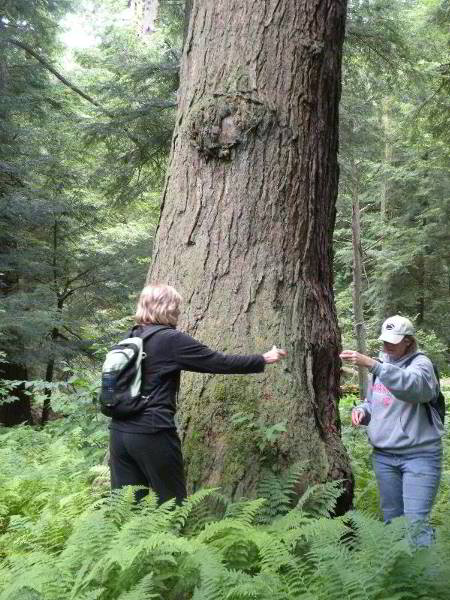 fat hemlock at Hearts Content fat hemlock at Hearts Content
http://www.dcnr.state.pa.us/forestry/oldgrowth/heartscontent.aspx
"There are gnarly old beech snags amid a carpet of ferns.
The ferns themselves are an indicator of a major problem in this
forest. The ferns are almost the only plants not eaten by the
over-abundant deer. Deer browsing in the past has removed virtually
all of the understory shrubs and tree seedlings. It is exciting for
visitors who come here regularly to note that this is changing, in
part because of installation of protective fencing to keep the deer
out. Now saplings as much as five feet tall can be seen scattered
through the understory, a condition that wasn't possible in the past
several decades. The forest is changing, in spite of all diligence
on the part of humans. Disease plays a large role in these changes.
Beech bark scale is killing most of the large beech trees. It can be
seen on the big beech trees as tiny white spots scattered over the
smooth light gray bark. Smaller beech trees continue to sprout from
the spreading roots of the dying larger trees, but they rarely grow
to maturity. This is a problem, since the beech saplings come to
dominate many areas of the forest floor and crowd out other trees
that would grow more successfully. Beech saplings can be spotted
easily in the winter because they retain their papery tan leaves."
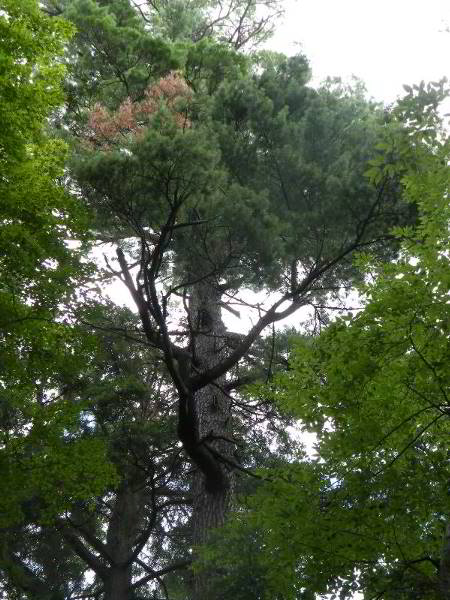 white pine crown white pine crown
This area certainly is changing. There are an exceptionally high
number, in my opinion, of standing dead white pines and dead
hemlocks compared to the number of older living trees. I
am not sure why so many of the large old white pines seem to be
dying. Maybe Dale has a different perspective on the area. I don't
know. We ran our fourth transect through a section of this site,
then continued around the interpretive trail. I found myself taking
many photos of crown structure in the old hemlock and white pine
canopy trees.
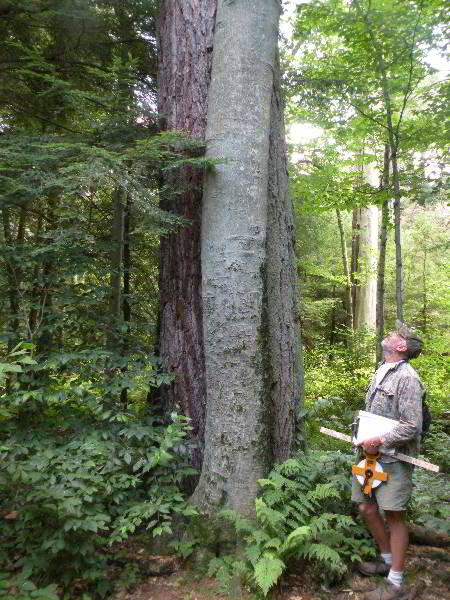 conjoined beech and hemlock trees conjoined beech and hemlock trees
There were a couple of other trees I want to mention that caught
my eye. One was a pair of white pine and beech trees that were
growing together right beside the trail This was an excellent
example of what we called conjoined trees in out Multitrunk
discussions earlier.
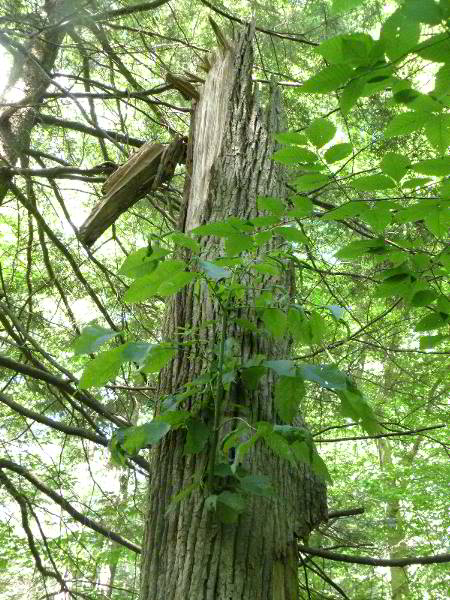 Cucumber tree hanging on Cucumber tree hanging on
Another was a snag of cucumbertree, perhaps ten feet high and a
foot in diameter - only it wasn't exactly a snag. It was weathered
and broken, but near the top was a single green shoot of a branch,
wilted, but alive growing upward along the tree surface. It was
somehow still alive.
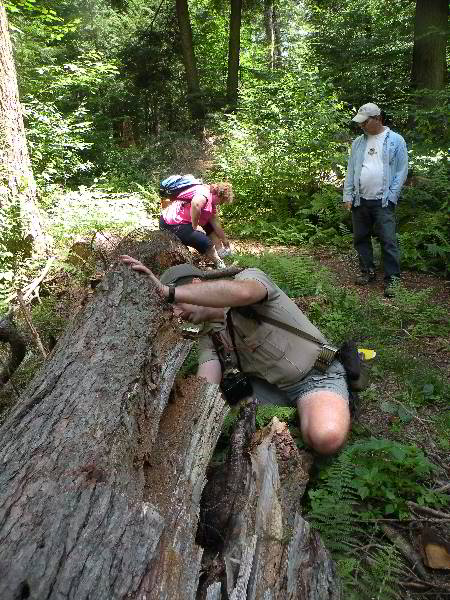 Bonus photo - Dale Luthriger counting rings on a 170+ year old
fallen white pine Bonus photo - Dale Luthriger counting rings on a 170+ year old
fallen white pine
After leaving this site, everyone headed back to Cook Forest
where the teachers had evaluations ad other paperwork to complete.
Earlier in the day I had offered to take anyone interested on a
quick hike back to the Longfellow Pine and the cucumbertree at Cook
Forest.they had missed because of time constraints earlier. When I
mentioned it, many people seemed interested, but by the time the end
of the day was here, only one person took me up on the offer.
I posted two short video clips from the workshop on YouTube:
Old Growth Forest Ecology Teachers Workshop
http://www.youtube.com/watch?v=rUS0nteLv3o
Dale Luthringer discussing aspects of the old growth forest at
Cook Forest State Park, PA, USA during an Old Growth Forest Ecology
Teachers Workshop held there on August 06-07, 2009. Dale Luthringer
discussing aspects of the old growth forest at Cook Forest State
Park, PA, USA during an Old Growth Forest Ecology Teachers Workshop
held there on August 06-07, 2009.
Using an Increment Borer
http://www.youtube.com/watch?v=VWsqGoNji4o&feature=PlayList&p=785729A...
Tree coring demonstration given by Dale Luthringer as part of an
Old Growth Forest Ecology Teachers Workshop held at Cook Forest
State Park, PA, USA on August 6-7, 2009.
Ed Frank
Continued
at:
|